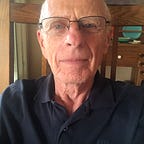Barnaby Conrad Decided He Could Do Better Than the Matador
He’s the writer Hemmingway hated — here’s why
As a 19-year-old art student attending a bullfight one summer in Mexico, Barnaby Conrad impulsively decided he could do better than the matador. So he leapt into the ring and, using his coat, dared El Toro to have a go. Best part of that story… he escaped with his life…and one teensy weensy gore… or, as they say, he lived to fight another day.
After graduating from Yale he went to Spain to study art and subsequently worked for the State Department serving as a young vice consul. It was here that he leapt into that first bull ring. (Thanks NYTimes and The Paris Review for the info.)
But he did lots more of everything, and that’s the reason for his notoriety.
He lived to fight 40 more bulls (with training, this time) in Spain, Mexico and Peru known then as El Nino de California. In his 90 years, he also wrote more than 30 books and magazine articles, many on bullfighting: Matadore, The Death of Manolete, Learning to Write Fiction from the Masters, 101 Best Beginnings Ever Written, The Second Life of John Wilkes Booth, some fiction and others.
He was a renowned portrait painter with works now hanging in the National Portrait Gallery collection and he was a pretty good cocktail pianist too.
He co-founded the Santa Barbara Writers Conference, was a reformed alcoholic and befriended many famous authors: Sinclair Lewis, John Steinbeck, William F. Buckley Jr., Ray Bradbury, Alex Haley, James Michener, Truman Capote to name a few… but notably, not Hemingway who hated him, though they never met, for doing everything in what Hemingway considered his domain.
Conrad later opened his San Francisco nightclub, El Matador, named after the title of his first book. The social elite called it West Coast’s answer to New York’s Stork Club. Wallis Simpson, Marlene Dietrich, John Wayne, Frank Sinatra and other notables drank and smoked there.
But the one thing I can best relate to is his 1961 book, Famous Last Words, a collection of final statements of well-known people. His introduction in the book reads:
“There are a few tragic and bitter ones, of course, but on the whole, after reading thousands of deathbed utterances, one is struck and comforted by how comparatively pleasant dying is reported to be. Especially when compared with other ordeals. Such as living, for example.”
I love famous last words… I spend hours — figuratively, honestly — thinking of what to say other than “Holy #@%&!” if I see the headlights coming at me. Here are some of the better:
- Either the wallpaper goes or I do — Oscar Wilde, 1900
- I should have never switched from Scotch to Martinis — Humphrey Bogart, 1957
- Mind your own business — Wyndham Lewis, in response to his nurse asking how his bowels were doing.
- FIRE! — Joe Hill just before his execution by firing squad in Utah, 1957
- Get my swan costume ready — Ballerina Anna Pavlova
- Mayonnaise — Writer Richard Brautigan who always wanted to end a book with that word… and he did. 1984
- Oh good… for a moment I thought we were in trouble — Butch Cassidy to the Sundance Kid just before… oh, you know.
- Don’t let it end like this. Tell them I said something — Pancho Villa
- Eureka… I have found the secret of life. It is… aaargh — Me. I’ve got to go now.
By Jerry Constantino
